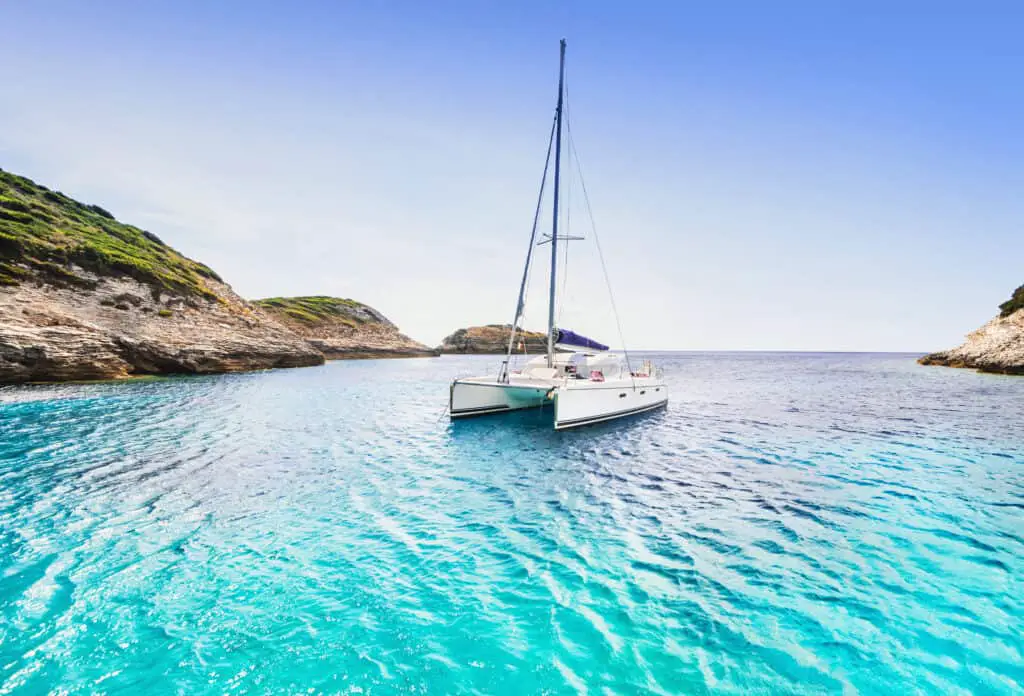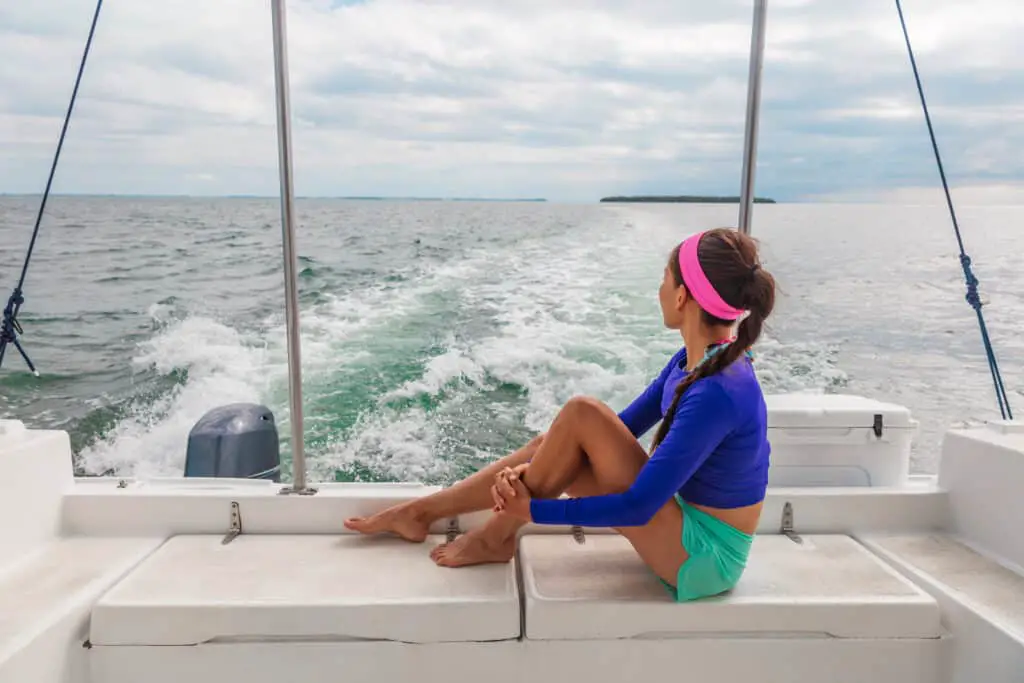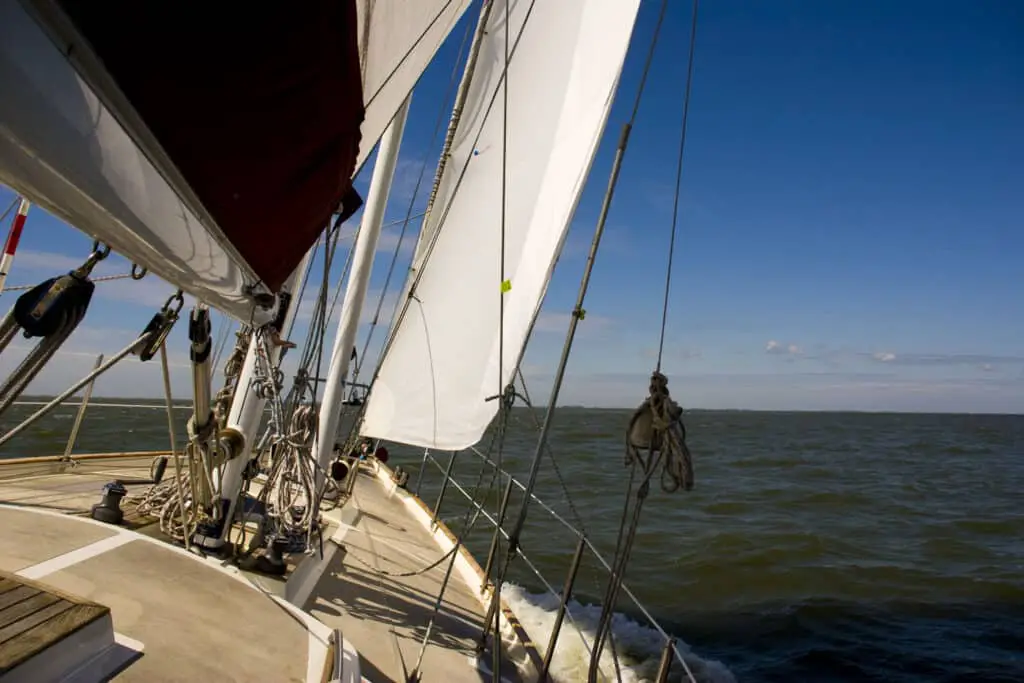As an Amazon Associate, we earn from qualifying purchases. We may also earn commissions if you purchase products from other retailers after clicking on a link from our site.

Many are the stories of (monohull?) sailors telling the world that catamarans cant sail upwind, although to some extent this might hold some value, it is definitely not the entire story.
Although it depends on the size of the boat and the weather of the sailing location, a typical catamaran can sail 45 degrees windward to the true wind and up to 14 knots in ideal conditions. In less ideal conditions, results may vary and numbers change.
Take a look below for more tips on catamarans, ways to sail “through the wind” and more!
What Is a Catamaran?
A Catamaran, like a yacht, is a boat made for recreation and cruising. The main difference between the two is that, unlike a yacht, a catamaran is a boat with twin hulls (instead of the traditional one), that are equal in size and resting parallel to each other. The two hulls are connected by a superstructure (or wide beam). This is where the boat gets its main source of stability.
Specs
There are tons of different types of catamarans out there to admire, but to give some basic information on just a few, here are three of the top-grossing catamarans, ranging from 40-60 feet long:
Bali Catspace
- 40.45 feet long
- Maximum Beam is 21.62 feet long
- Engine goes from 2 x 20hp – 2 x 30hp
Leopard 50
- 50 feet long
- Maximum Beam is 26 feet long
- Engine goes from 2 x 57hp
Sunreef 60
- 60 feet long
- Maximum Beam is 33.5 feet long
- Engine goes from 2 x 75hp – 2 x 110hp
So, depending on the size of your boat and the weather forecast for the day, most of the aforementioned models could handle getting mighty close to the wind. Catamarans such as these can get as close as an angle of 35 degrees, or even up to 50 degrees off the wind.
Sailing for Beginners

For those just starting out with sailing, you may be asking yourself: “what does it mean to get close to the wind?” Or, maybe even a step further, “why does it matter?”
Everyone who has ever seen a boat in action (in real life or the movies) knows that in order for a boat to “go”, it needs some help. Yes, engines help get things going, just as oars help get a boat moving, but the key to all sailing is actually the wind.
Wind
Wind points a boat in the right direction and urges it forward into whatever landscape it’s exploring. But winds can be tricky because they are constantly changing their directions, temperaments, and strength. Because the wind is nothing to mess with, a sailor needs to know that it is impossible to sail directly into the wind. But, to get in a direction and get there fast, you want to sail as “close” to the wind as you possibly can.
It’s risky business being so close, and managing the right closeness to the wind is a fine line. Staying close to the wind (angling your boat somewhere around 35-45 degrees, or even 50 degrees against the wind), will get you started. However, if you get any closer or any degree sharper, you could risk flipping.
To sum things up, the whole point of angling your boat as close to the wind as you can is making sure you use the wind to your advantage, allowing these natural resources to propel you and your boat forward. Doing this safely will. help you avoid cutting too close to the wind and endangering yourself and your catamaran.
Wind Awareness
Now that we are a bit more familiar with the basics, here’s a deeper look into the nautical world.
As we’ve discussed, the wind is an essential tool in sailing, but what we haven’t discussed is what kind of wind is essential. No, there aren’t different types necessarily, but there are different ways to categorize the wind and different ways to perceive it. These different ways are important for every sailor to know.
First, there’s True Wind. True wind is the speed and direction of a given wind through the perspective of a stationary observer.
(Ex: That guy with an eye patch in every pirate movie that’s standing in a small cubby at the top of the mast, yelling down to everyone from the lookout that there’s “a storm brewin'”)—he would be the stationary observer, testing the wind’s speed and direction.
Then, there’s something called Apparent Wind. Apparent wind is the speed and direction of a given wind through the perspective of a non-stationary observer.
(Ex: The pirate boat with black sails decides to go against the wind, making all the pirates abroad feel the wind in its most concentrated form. Beards are flying everywhere and no one can see much). In this case, the true wind combines with the wind pushing against the vessel to make it seem like the wind has increased its velocity when nothing has really changed except the amount of resistance.
Both are important to know because, while true wind helps a sailor decide when to leave for a given venture, the apparent wind is what helps a sailor decide which routes to take.
Tacking vs. Jibing

Now, to dive deeper, we’ve got some new sailing terms: Tacking and Jibing (or “gybing”).
To keep in our theme of the wind, tacking and jibing are tactics sailors use (or don’t use depending on the situation), to manipulate the wind to their advantage.
Tacking
To change directions, sailors “tack”. So, say you’re on your brand new catamaran and the wind is blowing against the right side of the boat. But, because you want to change the direction your boat is headed, you want it to be blowing against the left side. You’d have to tack.
To do this, you would want to lead the bow (the front of the boat) headfirst, fearless into the wind. This would allow the wind to change from hitting the right side of your boat to the left, resulting in the desired directional change.
Jibing
The complete opposite of tacking, jibing is launching the stern (back end of the boat) into the wind so you are able to sail away from the wind and change directions.
Both these maneuvers can help someone sail a catamaran safely, so long as one never forgets to use the wind and to use it well.
